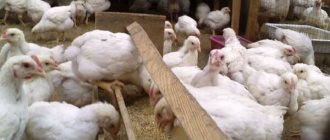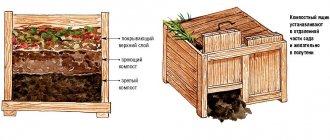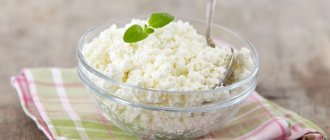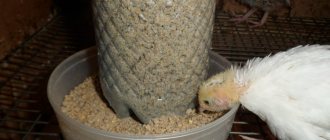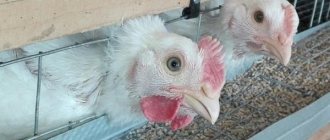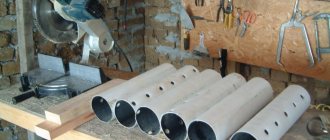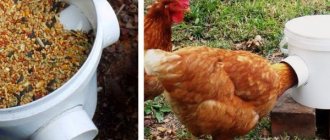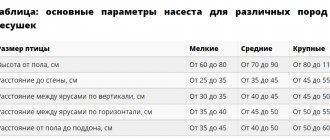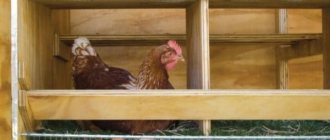Broiler chickens have long become the constant companions of any successful poultry breeder and farmer. Raising these pets does not take much time, and the result is worthy of all praise. Broilers gain weight much faster and more actively than other breeds, and are also easy to care for and resistant to typical diseases and living conditions. At the same time, truly good results cannot be achieved if you do not adhere to the basic rules for cultivation, among which special attention is paid to nutrition and feed composition. Our article provides all the necessary information about the composition of feed for broilers, as well as options for making such mixtures at home.
About feed for broilers
Breeding chickens of meat breeds involves an intensive method of raising young animals, balanced feeding and clean, natural feed. The use of compound feed in feeding young animals allows birds to gain the required slaughter weight in a shorter time and keep the meat tasty and tender.
Industrial feed has a number of disadvantages: improper storage conditions, dishonesty of the manufacturer, inclusion of cheaper synthetic products that replace amino acids and proteins. Low-quality feed is easily identified by the white powder remaining in the bird feeders. Artificial components not only slow down the processes of growth and weight gain, but also affect the taste of poultry meat.
Good commercial feed is quite expensive, so many breeders prefer to feed their birds with grain and vitamin supplements, and also make their own feed.
The main components of homemade feed are corn and wheat. The maximum effect will be obtained by feeding broilers with feed mixed with fresh grass and vegetables. Industrial feed differs not only in composition, but also in the size of the granules. Chicks will not cope well with adult pellets. Therefore, when making feed for broilers with your own hands, you should take this feature into account. Pelleting is an optional but desirable process because it preserves nutrients. The disadvantage is that the production process becomes more expensive.
Optimal composition of feed for broilers
The meat production of domestic chickens requires high-calorie nutrition. Therefore, when purchasing combined feeds, you need to pay attention to their composition. Compound feed for broilers must contain:
- proteins;
- vitamins and mineral components;
- protein (its source is grass flour);
- corn;
- feed wheat.
The composition of the feed may vary, but the ingredients listed above are mandatory components.
Feeding broilers with compound feed
A separate type of feed for broilers is produced for each age category. When making feed at home, it is necessary to change the recipe depending on the age needs of the bird. During production, it is necessary to know the daily feed requirements of the broiler in order to avoid feed losses during long-term storage.
Depending on age, one chicken on average requires:
| Age of the chick in days | Daily feed rate in grams |
| 3-7 | 10 |
| 8-14 | 25 |
| 15-31 | 50-120 |
| Over a month old | 150 |
In the first seven days, the chicks are fed eight times a day, then the meals are gradually reduced by two feedings and brought to twice a day. Newly hatched chicks are given chopped fresh herbs, boiled chicken eggs and cottage cheese along with feed. Natural feed helps improve immunity and promotes good growth and development of the chicken. Compound feed is given in crumbly form or added to mash.
The disadvantage of mash is that it quickly sours, so not all poultry farmers approve of this method of feeding.
Some farmers who keep large numbers of livestock and poultry prefer to feed all livestock with one type of food, reducing food costs. Most often, this role is played by pork feed. It contains fiber, salt and chalk in an optimal ratio. However, when giving it to broilers, it is necessary to add calcium and a vitamin complex.
Starter feeds for feeding broilers at home
Successful rearing must begin with the size of broiler cages, based on the number of birds, and after that, purchase special feeds that have thematic names. They can be distinguished by markings, as well as by different fractions of dry particles.
For the smallest chickens they will be small, but the grown-up chicks are already quite capable of digesting larger particles. Typically, the process of raising birds lasts no more than 3–4 months, after which it is unprofitable. What are the feeding standards for laying hens can be found in the article.
Classification of broiler feed:
- PK6 - 1 is given to chickens from birth until two weeks. The composition contains a significant amount of crushed corn, which has a beneficial effect on the formation of bone mass and muscles. It also contains wheat, barley and all the necessary vitamins and minerals. Dry food will not replace fresh greens, boiled eggs, millet and cottage cheese - the main diet of chickens at this age, but its use will help to significantly increase the survival rate of chicks and determine further successful development.
- PK6 – 2 can be given as early as two weeks of age. Its name will be “growth”, which already determines the further impact. The mixture granules are larger, the nutrient content is slightly changed, not in composition, but in percentage. Also, the food at this age is additionally enriched with fish and bone meal, lysine and vegetable oil.
- PK6 – 2 is intended for feeding birds from a month before slaughter. Its name “finish”, fractions and composition differ from the previous two. It is optimal to combine dry food with cereals and vegetable matter. This is not only the most beneficial for the birds, but also more economically profitable than feeding broilers exclusively with compound feed.
You can see what the Orpington breed looks like in this article.
Video composition of feed for broilers:
The simplest and most reliable option is to buy ready-made mixtures for feeding birds, combining them with fresh vegetables, grass and food waste. This method is guaranteed to give reliable results, but the cost of such cultivation will be somewhat inflated. This is especially unprofitable if the farm has a fairly large number of livestock. It will be much cheaper to make feed for raising broiler chickens yourself. How to simplify this process as much as possible, and possible options for mixtures for creating mixed feed are presented in further information.
You can see what the Cochin breed looks like in the photo in this material.
What is needed to make feed at home
To approach this process as seriously as possible, you need to take care of purchasing special equipment. First of all, these are household grain grinders, which will help make the desired grain fraction.
Feed recipes for broiler chickens
The productivity of broilers directly depends on the type, quality and quantity of feed, as well as on the diet. For normal development of poultry, the feed must include:
- grain and cake. They provide the broiler with the necessary carbohydrates,
- fish, bone or meat and bone meal. It is a source of protein
- minerals and vitamins. The health of the bird depends on them.
- Fiber is poorly digested by birds, so its amount should not exceed 4% in the feed.
The basic composition of feed for broiler chickens is as follows:
- corn,
- wheat grains (whole or crushed),
- sunflower cake or meal,
- fish, meat or bone meal,
- yeast (it is better to use feed yeast),
- fresh grass (in winter - chopped hay),
- dry return,
- fat (it is recommended to use feed fat),
- vitamin supplements.
Depending on the age of the bird, the percentage of components varies. Vitamin supplements must contain vitamins A, B, D, K, folic, pantheonova and nicotinic acids, as well as copper, iron, selenium and zinc. If desired, you can add a small percentage of soybean cake, vegetable oil, soda and lysine.
Chicken feed recipes
You can prepare compound feed with your own hands for broiler chicks, one day old and older, according to the recipe most popular among breeders:
- corn dirt - 50%,
- 15% - finely ground wheat,
- 15% - sunflower meal,
- 12% - low-fat kefir,
- 8% - ground barley.
Second recipe for chicken feed:
- 73% - corn, wheat and barley in equal proportions,
- 13% - soybeans,
- 13% - milk powder,
- 1% - small shell rock, chalk or premix.
Starter feed recipe
Starter feed is given to chicks from two weeks of age, that is, at the stage when they are actively gaining weight and developing the body.
Therefore, the feed should contain a large amount of protein and calcium.
Starter feed includes:
- 47% - ground corn,
- 20% - cake,
- 13% - ground wheat grains,
- 8% - bone meal,
- 5% - feed yeast,
- 3% - fresh grass or grass meal, depending on the season,
- 1% - feed fat.
Another recipe for preparing starter feed:
- corn - 45%,
- wheat - 10%,
- makukha - 15%,
- soybean - 10%,
- fish or meat meal - 9%,
- feed yeast - 5%.
The remaining 6% is chalk, shell rock, premixes, grass meal or fresh grass.
Do-it-yourself feed composition for broilers
Buying broiler chickens is a profitable investment because this group of chickens gains weight incredibly quickly. After just 2 months you can have a quite weighty carcass on the table. Fast-growing chicken breeds are especially popular among farm owners. This is an ideal option for building a profitable business. But in order for everything to go according to plan, it is important to pay special attention to the nutrition of chickens. Today we will discuss how to make feed for boilers with your own hands (recipe).
Making feed yourself adds a lot of hassle, but has clear advantages:
• financial savings; • confidence in the quality of the composition; • the ability to adjust the recipe as necessary.
You need to start caring about the proper nutrition of broilers from the very beginning. When preparing your own mixture, it is important to make sure that the recipe is appropriate for the age of the bird. As the chickens grow, the composition of the feed should change. This will ensure the broilers gain weight quickly.
Typically, changing the diet of broilers takes place in three stages:
1. Pre-launch - 0-14 days; 2. Starting – 14-30 days; 3. Finish - 30-60 days.
The feed recipe for small chickens is not the same as for adult birds
Finishing feed recipes
Finishing compound feed is used to feed birds from the 30th day of life until the moment of slaughter. It contains the most calories and allows you to get a good daily gain.
One of the most popular finishing food recipes:
- 50% - corn flour or ground corn grains,
- 17% - cake,
- 12% - meat and bone or fish meal,
- 12% - crushed or ground wheat,
- 6% - yeast,
- 3% - chalk, premixes, herbal flour.
The cooking recipe can be changed slightly by reducing the percentage of fishmeal to 7 and increasing the percentage of grass, feed fats or skim milk.
The second composition of feed for broilers:
- 32% - corn,
- 20% - wheat,
- 25% - soybeans,
- 18% - cake.
The remainder is chalk, salt, premixes, herbal or fish meal.
This feed composition guarantees good feed moisture, contains about 20% protein, 7% fat and a minimum of fiber.
Any of the mixed feeds will be more effective if the feed is first yeasted. This procedure will not only increase the absorption of nutrients, but will also avoid vitamin deficiency, intestinal problems, and improve the taste of poultry meat. An adult broiler should be given no more than 25 grams of this food per day, and chicks should be given no more than 10 grams.
What does it consist of - the composition of fattening feed for chicken
The basis for creating dry food is determined by the content of the main component. For raising chickens, it is best to use corn or wheat. You cannot add barley, oats, peas and soybeans, but the first two types of grains will still have the maximum content.
To provide all the needs of the poultry, oilseed crops must be added to the mixture. In our conditions, the simplest option is sunflower cake (meal). If you don’t have a special oil press, you can simply buy ready-made layers, but it will be more economical to make them yourself.
Find out what the Pavlovsk golden breed of chickens looks like.
on the video composition of feed for broilers at home:
It is necessary to improve the composition and ensure the full development of the bone skeleton with the help of special additives - fish and meat and bone meal, chalk and calcium preparations. The composition also includes vitamin supplements and microelements. To do this, it is better to purchase special preparations, the cost of which will not be too reflected in the total amount compared to purchased feed.
You can find out what the Black Saxon breed looks like by following this link.
Additional elements: feed fat, chalk and salt are added according to the age and needs of the growing young animals.
Feed can be given in the form of mash or in a dry form. In any case, it is necessary to take care of the constant availability of clean water so that the birds do not suffer from thirst after dry particles.
Yeasting of compound feed
Both the finished product and its constituent components can be subjected to yeasting. But most often, breeders perform yeasting of ready-made feed.
- Yeast process:
- Take about 20 grams of fresh yeast,
- One and a half liters of warm water,
- A kilogram of feed is added to the mixture of water and yeast,
- Mix and place in a warm place for 7 - 9 hours.
This food is fed within several hours after preparation is completed. You can add a little grated sugar beets, carrots, molasses, sprouted barley or sour milk to the mixture.
